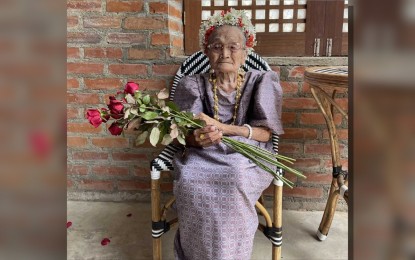
LIVING TREASURE. Magdalena Gamayo, a National Living Treasure awardee, celebrated her 99th birthday last Aug. 13. Local officials and her community in Lumbaan, Pinili, Ilocos Norte gifted her with a fiesta-themed party. (File photo by Leilanie G. Adriano)
LAOAG CITY – At 99, Magdalena Gamayo, the grandmother of handwoven cloth Abel Iloko, continues to weave the finest inabel textiles with a very high thread count and intricate designs that sometimes can take up to five colors.
Every day, her local community in the farming village of Lumbaan, Pinili, Ilocos Norte, where she taught the traditional art of inabel, would see her work on her loom just like a kid playing with her favorite toy.
“Weaving fascinated me very much,” Gamayo said in an interview Monday, ahead of her trip to Metro Manila this week in time for her month-long exhibit at the National Commission for Culture and the Arts (NCCA) Gallery inside Intramuros, Manila.
Her original artworks, along with the works of over 30 National Living Treasure Awardees, will be shown to the public free of charge.
The project is headed by Edwin Antonio, chair of the Northern Cultural Communities of the NCCA, and with materials curated and written by Bernard Joseph Esposo Guererro, a textile consultant and cultural worker. Both experts hail from Ilocos Norte.
Gamayo’s exhibit, dubbed "Inubon a Dayaw (String of Honor), will showcase her journey as the oldest national living treasure in the country.
In 2012, the Philippine government recognized her as National Living Treasure awardee, catapulting her to a rank similar to national artist.
This recognition, according to Nana Dalen (as Gamayo is fondly called), has changed her life including the local weavers whom she trained and are still training up to this date.
“Age has not withered her away. More than anything, she has never been as passionate as she has been now in safeguarding the tradition,” said Guererro, as he underscored that the exhibit is not for profit but to realize Gamayo’s desire that the weaving tradition should never be lost for the appreciation of the future generations.
Gamayo said she enjoys her craft from beginning to end, transforming a natural fiber into a work of art.
In the olden times, textiles were produced not for fashion but for practical reasons. If not for shirts and dresses, these are used to make blankets.
None of Gamayo’s older works survive largely due to an essential Ilocano practice.
“I have seen so many people dear to me going ahead, and often I feel that it is my responsibility to gift each of them blankets for them to use in the afterlife,” she said.
Among Ilocanos, blankets happen to be the most important “paba-on”, or parting gift, to be given to the dead.
As Gamayo hails from a remote village, Guerrero said "Gamayo’s talents have not been realized and recognized as early as they should have been as she had been enormously overshadowed by weavers closer to the center who have better opportunities to make their work more accessible.”
“That, however, may have worked to Gamayo’s advantage as it only meant that her craft was untainted by outside influences; therefore, keeping her artwork, style, and philosophy in their purest forms,” he said.
Luckily, Gamayo’s October 2023 exhibit will showcase all her original artworks, at least three of which are her oldest living works and exclusively for visitor’s eyes only, Guererro added. (PNA)
